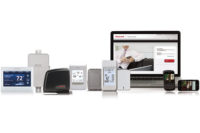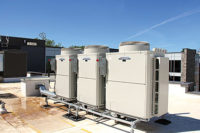In the aftermath of a brutal 2013-2014 winter that included a widespread propane shortage and record high propane prices across much of the U.S., several states are introducing or expanding tax credits, rebates, financial assistance, and training to help promote biomass heating for both commercial and residential applications.
And while those familiar with biomass heating are acutely aware of its numerous benefits and versatile applications, others remain unfamiliar with the recent technological advances that have made biomass heating an efficient, viable option for many customers.
Not Your Grandpa’s Wood Stove
Though biomass heating is not practical in some regions, areas like New England, the Midwest, and the Pacific Northwest are increasingly turning to biomass as an affordable way to heat buildings during the colder months — especially as fossil fuel prices remain unstable.
But, as Biomass Thermal Energy Council (BTEC) executive director Joe Seymour noted, the biomass systems of today are a far cry from the wood stoves of yesteryear.
“One of the images we battle is the perception of the old, smoky wood stove, or grandpa’s wood stove,” he said. “There has been tremendous innovation in the past couple of years with temperature sensors and emission controls.”
Many wood pellet systems are now automatically fed from a bulk fuel hopper, he added, and many of the systems available include microprocessors that can track system diagnostics. “You can set the temperature you like, and the systems will even send you a text message or email when you’re running low on fuel.”
John Siegenthaler, principal at Appropriate Designs, a design and engineering firm specializing in hydronic heating, said biomass boilers, which are a focus of many new state incentives, have made leaps and bounds in recent years when it comes to efficiency and emissions.
“In a standard wood stove, you have single-stage combustion, but with these modern biomass boilers, you have two-stage combustion,” he explained. “They’re heating the wood to the point where it drives what are called the pyrolytic gases out of the wood, and then they’re mixing that gas with air in very specific proportions, like a carburetor mixes gas and air in a car. They’re igniting and burning that. It burns up more of the chemical content than a single-stage furnace.”
In addition to the increased efficiencies, biomass boilers and furnaces are carbon neutral, Siegenthaler said. “What that means is that if you let trees grow, they absorb CO? through photosynthesis. If the tree dies and rots in the forest, that carbon is going back into the atmosphere anyway. When you burn it, you’re going to release that carbon back into the atmosphere. The difference is we’re not taking carbon that’s millions of years old from under the surface of the earth and adding it into the atmosphere.”
Increasing Incentives
With the announcement of two new programs aimed at promoting renewable heating in New York and Massachusetts, it’s clear that state incentives for biomass heating “are really on a roll, and we’re seeing trends now,” said John Ackerly, founder and president of the Alliance for Green Heat.
“Residential wood heat has risen dramatically — over 100 percent in some states in the Northeast and Great Lakes [regions],” he said. “Incentive programs are a way to guide consumer purchasing and guide them to cleaner [technologies]. … The goal is to get this technology off the ground.”
Though many states have some kind of incentive in place for biomass heating, a growing number of states are increasing and actively promoting their incentives for a variety of reasons.
In Alaska, Devany Plentovich, program manager, Biomass/CHP, Alaska Energy Authority, said his employer has programs in place to promote high-efficiency wood heating, including a program to help residents switch over to high-efficiency biomass furnaces and boilers in order to reduce pollution from inefficient, single-stage wood-burning stoves. But there are economic advantages to moving to biomass heat, too, she said.
“We ship in barges of diesel fuel to these communities that are isolated and not on our road system, and the electricity is supplied with diesel generators on isolated grids. A lot of people use fuel oil, and, for a lot of them, it can be $10 per gallon. It’s a huge cost to heat these communities,” Plentovich said. “We see high-efficiency wood heating not only as a cost savings for the community, but also as energy independence. If we’re using local wood, the money is staying in these isolated communities.”
In New York, Gov. Andrew Cuomo recently unveiled the Renewable Heat NY program, which aims to promote the use of biomass heating on the commercial level. The idea is that encouraging commercial adoption of the technology will help drive prices down, making it a feasible option for residential applications, too.
“This initiative will lower costs for high-efficiency, low-emissions wood heating systems and create greater acceptance in the market,” said John B. Rhodes, president and CEO of the New York State Energy Research and Development Authority (NYSERDA). “NYSERDA will jump-start the initiative with large anchor projects, which will help increase demand for wood pellets and decrease costs for smaller residential and commercial customers as the market grows.”
“New Hampshire has a 30 percent tax credit for qualifying two-stage combustion biomass systems,” Siegenthaler added. “I think Vermont also has it, and Maine is either working on it or has it.”
“Where you’re seeing the deployment of the leading-edge technologies are in states that have the highest incentive to convert, like Maine, Massachusetts, New Hampshire — places that are tied to these high fuel prices and have access to an abundant number of trees,” Seymour explained. “The Northeast is really taking off because you have competing fuel that folks want to transition from, you have a healthy forest product sector, and you have incentives in place. Biomass is a distinct possibility where there are existing forestry resources and byproducts being produced.”
“I think you’ll see a growing interest in biomass heating in Wisconsin, Minnesota, and even Illinois, Indiana, the upper Midwest, Pacific Northwest, and Alaska,” Siegenthaler added. “I’d liken it to a new form of solar. I say that because if you look at a tree, it’s stored solar energy. We’re using stored solar energy when we burn wood.”
Changing Perception
Despite the benefits, making potential customers aware of biomass heating advantages is proving to be a challenge for organizations, including BTEC. “It has been difficult to move consumer perceptions,” Seymour admitted.
“We’ve got to get beyond this perception that it’s a dirty, smoky, redneck heating method,” Siegenthaler said. “These are some really refined products.”
Industry leaders agree a federal incentive might help move the needle on national acceptance, but no such incentive exists at the moment. “This is the reverse of the state level,” Ackerly said. “It’s going in the wrong direction.”
However, Seymour said biomass supporters are working hard to change that by introducing a federal tax credit — S 1007: Biomass Thermal Utilization Act of 2013, or the BTU Act, for short — which would provide up to a 30 percent investment tax credit for qualifying commercial installations. Unfortunately, the bill is “stuck in the Senate Finance Committee,” Seymour said. “If we can’t get it across the goal line in 2014, we’re going to seek a rethinking of our tax policy strategy,” he added.
For the moment, state-level support will continue to shape the future of biomass heating in the U.S.
“The trend is toward boilers, not stoves,” Ackerly said. “We’ll probably see more boiler incentives.” Additionally, states like New York are beginning to require certified professional installations, he said.
In the future, regulatory action will likely impact the market, Siegenthaler said. “The EPA [U.S. Environmental Protection Agency] is developing something called the New Source Performance Standards,” which will likely phase out single-stage wood-burning furnaces due to the high emissions, he said. And, though he is generally wary of the EPA’s sometimes overzealous regulatory efforts, Siegenthaler said he would support cleaning up emissions from old, inefficient, dirty wood stoves.
“I don’t like to see the government making a lot of regulations, but, with this, I’ll make an exception,” he said. “It’s inevitable that it’s going to move forward and become a regulation.”
Ackerly agreed that federal emission standards are coming, and more states are requiring stricter emission limits.” He added, “In the future, we’ll see minimum-efficiency standards.”
In the meantime, manufacturers and industry organizations are continuing their efforts to promote high-efficiency biomass systems in areas where the market is ripe and state incentives are plentiful.
“It seems wherever you look, there’s no good news for oil — environmentally or economically. Propane is more versatile, but even there the price point of propane versus something like a ground-source heat pump, it’s not going to beat it,” Siegenthaler said. “When you look at these rural markets, where you have the resources, it makes sense. The biomass market is a really good contender.”
To view a map of available state incentives, visit http://bit.ly/BiomassIncentives.
Publication date: 11/17/2014
Want more HVAC industry news and information? Join The NEWS on Facebook, Twitter, and LinkedIn today!










